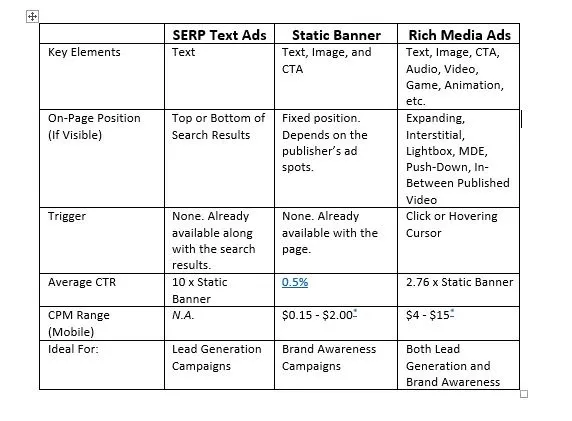Published on: 01 Dec 2020
Reading time: 11 minutes
A Primer on Rich Media Ads
The primary difference between rich media ads and other forms of ads is its focus on engagement. While other ad formats focus on lead generation or brand awareness using creative imagery, copy, or CTAs, rich media ads give the brands and agencies the freedom to use videos, interactive elements like games, and other media files along with the conventional text and images.
Since rich media ads have a wider scope of application, they cover a large set of metrics. For instance, apart from the usual CPA, CPC, CTR, and other similar metrics, rich media ads tend to measure pause rates, skip rates, expansion rates, 75th percentile video completion rates, etc. Along with this, there is an element of permission-based advertising as many rich media ad formats tend to unfold into their full form only after a user interacts with it.
Google accepts the following as the different variants of rich media ads:
Banners.
The banner rich media ads have a fixed size on the page. In terms of loading, the page loads before the ads. This way, the larger file size does not get in the way of the page loading speeds or hamper the organic rankings of the publisher. Banner ads can carry moving images or videos.
Dynamic Creatives.
Dynamic Creatives change the ad based on the content on the page or the user's interaction with the embedded link. This is more of a feature that covers banner, expanding, interstitial, and VPAID ads.
Expanding Ads.
Expanding ads grow out of their initial dimensions on the page. They either push the content down, lay over the content, or load before the page, depending on the page's setup and the ad itself. Expanding ads get triggered as the page after a user interacts with the ad by clicking on it or hovering the mouse.
Interstitial Rich Media Ads.
Interstitial ads are available as floating assets that hover over the page's content or are visible between page loading or launching instances. These ads can have an adaptive position that adjusts with the content on the page or a locked position triggered based on the campaign settings.
Google Lightbox.
Lightbox is an innovative format that allows brands and agencies to use their existing marketing collateral like product portfolios, videos, and other files in the form of a slider that covers the entire page. The ad gets triggered after a user hovers the cursor on the ad for two seconds or clicks on the ad, in case the device browsing device is a phone.
Multi-Directional Expanding (MDE).
MDE ads a layer of responsiveness to the expanding ads. The creative expands in a direction opposite to the one which already has an ad. This way, the motion draws attention to the creative, and it gets visibility even on an otherwise crowded webpage.
Push-Down Ads.
These ads push-down the content on the page and show the creative at the top. This format is available both in permission-based and triggered formats. However, once a user has been shown the push-down ad format multiple times for the same ad, it will get triggered only if the user clicks on it. Hence, the brand and the agency have to provide creatives for both the user-interaction-based and automatic push-down ad.
Video and Video Player-Ad Interface Definition.
Both Video and VPAID ads are designed to target videos. The VPAID format allows you to place ads before, between, or after the published-video content on YouTube. The video format allows you to place the video file in a rich-media format.
How are Rich Media Ads Different from Other Ad Formats?
The Distinctive Features of Rich Media Ads
Just by looking at the primer on rich media ads and the types of formats available, it becomes easy to determine that the focus is one creating engagement and making the ad stand out against typical video ads or static banner ads. But, it is worth exploring for every brand, agency, and publisher – what are the forms of distinctive features pertinently available only with rich media ads:
1. Audio and Visual Elements.
If you look at it from a first-principles perspective, rich media ads have wider 'basic ingredients.' Text ads have just the textual information and data available, which generally revolve around product data, seller information, and ongoing offers. Creative static banners have just the image, copy, and CTA to attract the user, establish the brand, provide relevant information, and direct the user to a landing page. Video ads can tell a story and have a CTA, but they tend to have an expensive production cost and running.
Rich media ads have more fundamental elements in the visual and audio sphere for the same ad spot. For instance – in a space where a static banner would only give limited information, a Google Lightbox ad can create an 'on-demand landing page' with the user's permission as soon as the user interacts with it. Similarly, while video ads tend to slow page loading speeds, rich media ads tend to get loaded after the entire page has been loaded. This helps the publisher keep the loading times in check, even if it supports relatively heavier rich media ads.
2. Permission-Based Triggers.
For most conventional ad formats, the user did not have any control except exiting the page, closing down the ad, or refreshing the page. Some of these actions were necessary to get rid of intrusive ad formats. While this deteriorated the user experience, on the one hand, it made the publishers face increased bounce rates and the advertisers to pay for false positives in the form of clicks that were not intentional.
Many rich media ad formats have an embedded functionality of unfolding only when a user interacts with it. For instance, Lightbox allows the advertiser to virtually showcase all interactive marketing collateral like videos, product images, and texts on the page in an expansive format. The ad gets triggered only when the user hovers the cursor on it for two seconds or clicks. This ensures that only the people who find the ad interesting are interacting with it, and the advertiser has higher chances of conversions per view. False positives get eroded, and the publisher doesn't have to worry about the bounce rates since the UX on the page is not disrupted by intrusive ads.
3. Added Layers Like Gaming Increase Engagement.
Even the most memorable static banners and videos can only have one-way communication with the user before redirecting to a landing page. Rich media ads designed as games allow the users to stay on the page and get an immersive experience. While this creates engagement for the user, it helps the advertiser and the brand garner increased brand awareness.
The rich media ads that have embedded games tend to deliver the brand's message more effectively. That can be one of the key reasons why they can be used for brand awareness and improve user intent for buying the product, i.e., lead generation. In one of our earlier posts, we explored how Mike's Harder Lemonade generated 75 seconds of interaction on the ad unit, where typical video ads cannot cross 10 to 20 seconds. The same campaign helped the brand to grow the purchase intent by over 53%.
4. Sizes of Rich Media Ads and Their Impact on Page-Loading Speeds.
Some publishers and agencies that are considering the operational aspects of the campaigns are often under the misconception that rich media ads can slow down the page loading speeds. At the same time, the publishers are worried that this will increase bounce rates and decrease the page's organic ranking. The advertisers are worried that they will pay for ad spots with decreasing user-traffic or sub-optimal traffic flow.
Google has supported its rich media ad formats keeping the page loading speeds in mind. That is why most of the sub-formats in rich media ads have a 'polite download technology,' which loads the ad after the entire page has been loaded. So, if the decreased page loading speeds were your only concern and stopping you from exploring rich media ads, you should immediately consider including them in your ad spots and campaigns.
5. Standard Metrics for Measuring the Impact of Rich Media Ads.
Google provides 50+ metrics to measure the performance of rich media ads. That makes this particular format one of the most comprehensively analyzed formats available across Google Display and Search Networks.
While these metrics cover standard formats like impressions, engagements, and reach, you can also analyze the following to optimize your campaign/creatives:
Display Time: This is the average duration for which the ad is visible on the page and is largely related to your bidding strategy and campaign design.
Interaction Rate and Time: This shows the percentage of users interacting with the ad out of the number of users who were shown the ad. Interaction time is the duration for which the users interact with your ad. The metric shows the efficacy of how well your ad can attract and retain attention.
Intentional Engagement: Also known as the dwell rate, the intentional engagement rate measures the duration of the engagement right after the very first touch, click, or interaction with the ad. It specifically focuses on how well can your rich media ad retain attention.
Expansion Rate: It measures the percentage of users who expanded the ad against total impressions. It shows your ad's capability to generate interest. The initial frame of your ad would be largely responsible for driving this metric.
Average Viewing Time and View Rate: Average Viewing Time shows you the median playing time against the total playing time of your rich media ad. It can give you feedback on the ideal length in time for your ad. The view rate is the number of engagements per view of your rich media ad.
Mutes, Pauses, and Exits: This is a straightforward set of metrics which shows the analytics for your rich media ads that use videos. It can give you feedback on the specific spots in your ads, which triggered action like pause, mute, or even exit.
Conversions and Revenues: Rich media ads have the ability to carry multiple links. This way, you can track which dimension of your rich media ad triggered the action. Hence, measuring conversions at the campaign level and sales for the business becomes easier.

Rich Media Ads, Video Ads, and Pop-Ups: How to Choose the Right Format?
The primary difference between rich media ads and video ads is the fact that video ads can often be intrusive and independent of user permission. Before the advent and wide adoption of rich media ads, most agencies and publishers were running video ads in a format that did not seek the user's permission. Both the video and the audio would start playing as soon as the page was loading. Hence, video ads were popular only on websites that carried critical information and had heavy traffic because that would be the only way to control bounce rates despite relatively slower page loading speeds and intrusive video ad formats.
The advertising ecosystem changed with rich media ads. Rich media ads solve both the problems by getting triggered generally when the user interacts with it. Formats like Lightbox, expanding ads, and push-down ads are common examples of ads that are triggered by user interaction. More than that, rich media ads have a focus on engagement. Hence, instead of impeding the user's experience, rich media ads try to engage the user with creative use of formats like games and other formats.
Since 2017, Google has been actively penalizing websites that show intrusive pop-up ads without user permission. The Google Display Network is actively updated to ensure no such websites are added to the platform. Additionally, pop-ups and pop-under ads also slowed the page loading speeds, hampering the organic rankings for the publishers. Hence, in essence, pop-ups were not preferred by anyone but the spammers.
However, pop-up ads served a very important purpose – they made the user take action to close the ad; otherwise, the users would often engage with the pop-up ad. In short, pop-ups were the insurance policy for advertisers that allowed them to deliver their message, no matter what.
Rich media ads can achieve the same feat with greater sophistication. Google Lightbox essentially serves more content than a pop-up ever would and is triggered by user-actions. Even the push-down format, which pushes the content to show the ad, can do so for a very limited number of times for one user. After that threshold, the user will have to interact with the ad for it to be triggered.
In Conclusion
Rich media ads provide a more user-engagement-focused, interactive, and creative manner to deliver brand awareness and lead generation campaigns. With sequence ads, you can get easily creative, cohesive narratives across different rich media ads. With embedded gaming ads, you can drive engagement exponentially beyond industry averages.
The only part that makes rich media ads trickier to produce than their static banner counterparts is the amount of resources necessary to produce the ad assets. With Airtory, you can actively produce different assets in varied, rich media ad formats using prefabricated templates that bring down production costs and timeline. Plus, with real-time analytics-driven campaign optimization and fraud detection, you can control your ad spends on the same platform.
To know more about how rich media ads and Airtory can help you produce value with your campaigns, explore this page.
Schedule a demo




